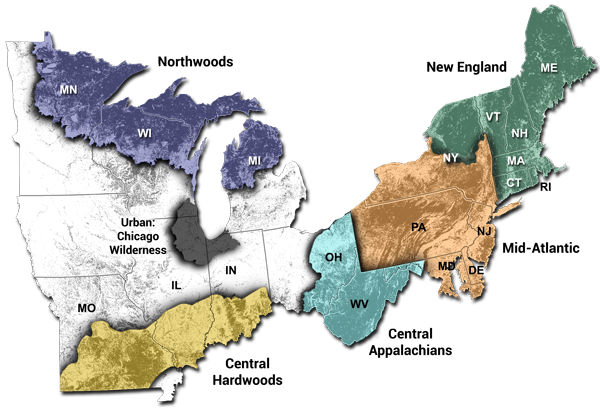Adaptation Approaches
The Climate Change Response Framework (CCRF; www.forestadaptation.org) is a collaborative, cross-boundary approach among scientists, managers, and landowners to incorporate climate change considerations into natural resource management. Since 2009, the effort has helped bridge the gap between scientific research on climate change impacts and on-the-ground management.
The CCRF stretches across forestlands owned and managed by private individuals, forest industry, tribes, state, local, and federal agencies across large landscapes. It was initiated with a joint commitment of the US Forest Service Northern Research Station, Eastern Region, and Northeastern Area State and Private Forestry to work closely together in addressing the challenges of climate change, and is led by the Northern Institute of Applied Climate Science.
CCRF Approach
The hallmark of the Framework, however, is the high level of cross-boundary cooperation among forest owners, considered essential to coping with an issue that spans borders, disciplines, and perspectives. The six step approach can be adjusted and applied to varied locations and landscapes.

-
Identify location, ecosystems, and time frame
This step outlines the geographic scale and extent of the analysis area, the ecosystems of interest, and relevant timelines for evaluating available information. These can be refined throughout the process as needed. -
Establish partnerships
Partners increase the amount and accessibility of information and ideas. Each project brings key partners into the process as early as possible and continues to identify new partners throughout the project. -
Assess ecosystem vulnerabilities and mitigation potential
Assessements synthesize both existing and new information to determine what species, ecosystems, or other features are most vulnerable to the effects of climate change. Input from both scientists and managers is important in putting the model results and other scientific information in context. -
Compile adaptation strategies and approaches
The available information on adaptation isn't always applicable at scales most relevant to land managers. In this step, broad adaptation strategies are evaluated within the context of the project area in order to create a menu of more focused adaptation strategies and approaches that are relevant to local land managers. -
Plan and implement at appropriate scales
Building upon earlier steps, land owners and managers devise adaptation tactics that are best suited to their needs and constraints. Just as there is a menu of adaptation strategies and approaches, diverse adaptation tactics may be identified to provide a range of choices . Implementation of adaptation tactics will vary widely across ownerships and through time in the same way that a wide variety of tactics is currently applied in forest management. -
Integrate monitoring and evaluate effectiveness
Monitoring is a critical step to evaluate whether management actions are effective in responding to climate change and reducing the vulnerability of ecosystems to changes that are occurring. Results from monitoring can be integrated throughout this framework to refine individual steps.
CCRF Components
Through the approach outlined above, each CCRF Project has four components that provide information and resources to its stakeholders.
-
Partnerships
Climate change is a cross-boundary issue because all lands will be affected in some way. Collaborative partnerships are the foundation for all activities. -
Vulnerability Assessment
High-quality information about future changes in climate and the potential effects on forest ecosystems helps to identify the forest communities at greatest risk. -
Adaptation Resources
A suite of information, ideas, and tools helps managers integrate climate change information into land management planning and decision making. -
Adaptation Demonstrations
Demonstration projects test new ideas and actions, grow partnerships, and provide real-world examples of climate change adaptation in forest ecosystems.
CCRF Projects
There are multiple ecoregional Framework Projects, currently encompassing over 130 million acres in nine states and including 11 National Forests in the Eastern Region. The CCRF is actively expanding, with new Projects under development in urban forests, the Mid-Atlantic, and New England. Up-to-date information on the CCRF is available through www.forestadaptation.org.

Map of CCRF projects: There are multiple ecoregional Framework Projects, currently encompassing over 130 million acres in nine states and including 11 National Forests in the Eastern Region.

